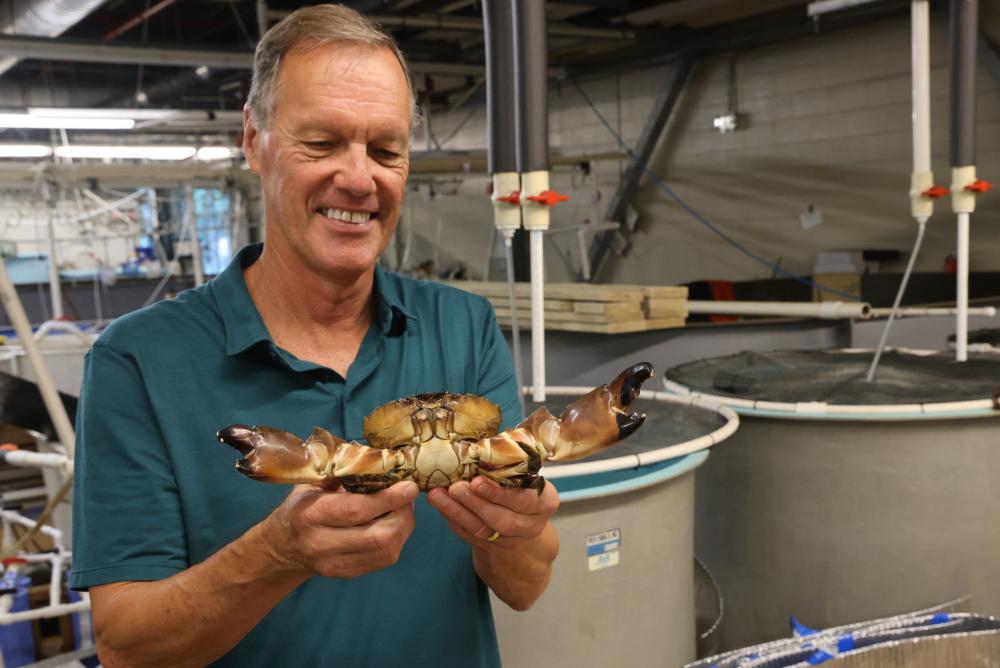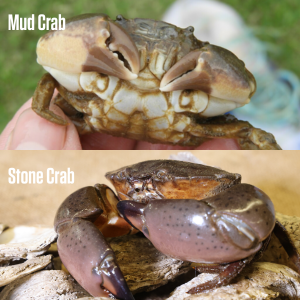Stone Crabs FAQ

William & Mary’s Batten School and VIMS are actively documenting the presence of stone crabs in Virginia waters. Local waterman Ty Farrington mentioned that he had been catching them at a Virginia Marine Resources Commission Crab Management Advisory Committee meeting, and he later brought us four adult stone crabs caught near Willoughby Spit.
Since our initial announcement on social media, we have received numerous additional documented sightings of live stone crabs, caught in crab traps and in one case on a fishing line, in the Chesapeake Bay. Stone crabs are native to Florida and have been observed in estuaries and lagoons as far north as North Carolina. These recent sightings suggest successful colonization of the Bay and the breaching of a biogeographic barrier by the species. If they are also reproducing in the region, it would represent the northernmost self-sustaining population recorded to date.
Professor Romuald Lipcius is currently working on a scientific publication documenting the northern migration of stone crabs into Virginia. He has received considerable interest from the public and commercial watermen. To address common questions and assist with identification, we have worked with Professor Lipcius to share additional information about the crabs and ongoing research efforts.
If you have legally caught a stone crab in Virginia waters, please email Lipcius at [[v|rom]] with details about the location and status of the crab, and preferably photos of both the top and bottom of the crab. *Please note that capture of stone crabs currently follows blue crab regulations. Professor Lipcius is compiling a map of confirmed observations, which will be shared here once available.
Stone Crabs FAQ
Q: What’s the value of having the crabs in hand, rather than just knowing where they were found?
A: Having physical specimens and photographs allows us to confirm the species accurately through morphological analysis and, potentially, genetic testing. This is critical for understanding how these crabs may be expanding their range.
Q: Could stone crabs impact the local ecosystem?
A: Based on a review of current scientific literature, we do not expect stone crabs to significantly disrupt the local food web. Species like blue crabs and Atlantic mud crabs already consume similar prey and coexist within the stone crab’s natural range. One study found that Atlantic mud crabs exert a greater influence on oyster populations than either stone crabs or blue crabs.
Q: Is the expansion into the Bay caused by warming waters?
A: Yes, this is known as “tropicalization” of marine ecosystems. The stone crab expansion is unique as the species has colonized the Chesapeake Bay, rather than just moving along the Atlantic coast. This is likely due to the crabs being able to survive the winter season due to warmer water temperatures in the Bay.
 Q: Are there other crabs in the Bay that look similar to stone crabs?
Q: Are there other crabs in the Bay that look similar to stone crabs? A: Yes, we have received numerous misidentified sightings, including European green crabs, Jonah crabs, Atlantic rock crabs, Asian shore crabs and, especially, Atlantic mud crabs. Atlantic mud crabs look very similar to juvenile stone crabs. The key differences are their size and the appearance of their leg markings and claw tips.
- The body of mud crabs can grow up to 2.5” across, while stone crabs are larger and can reach up to 6.5”.
- Stone crabs have pale horizontal stripes on their legs.
- Stone crab claws have prominent black tips, whereas the mud crab crusher claw has black fingers that fade to white at the base.
We appreciate your curiosity and engagement. Stay tuned for further updates, including the release of the observation map.

